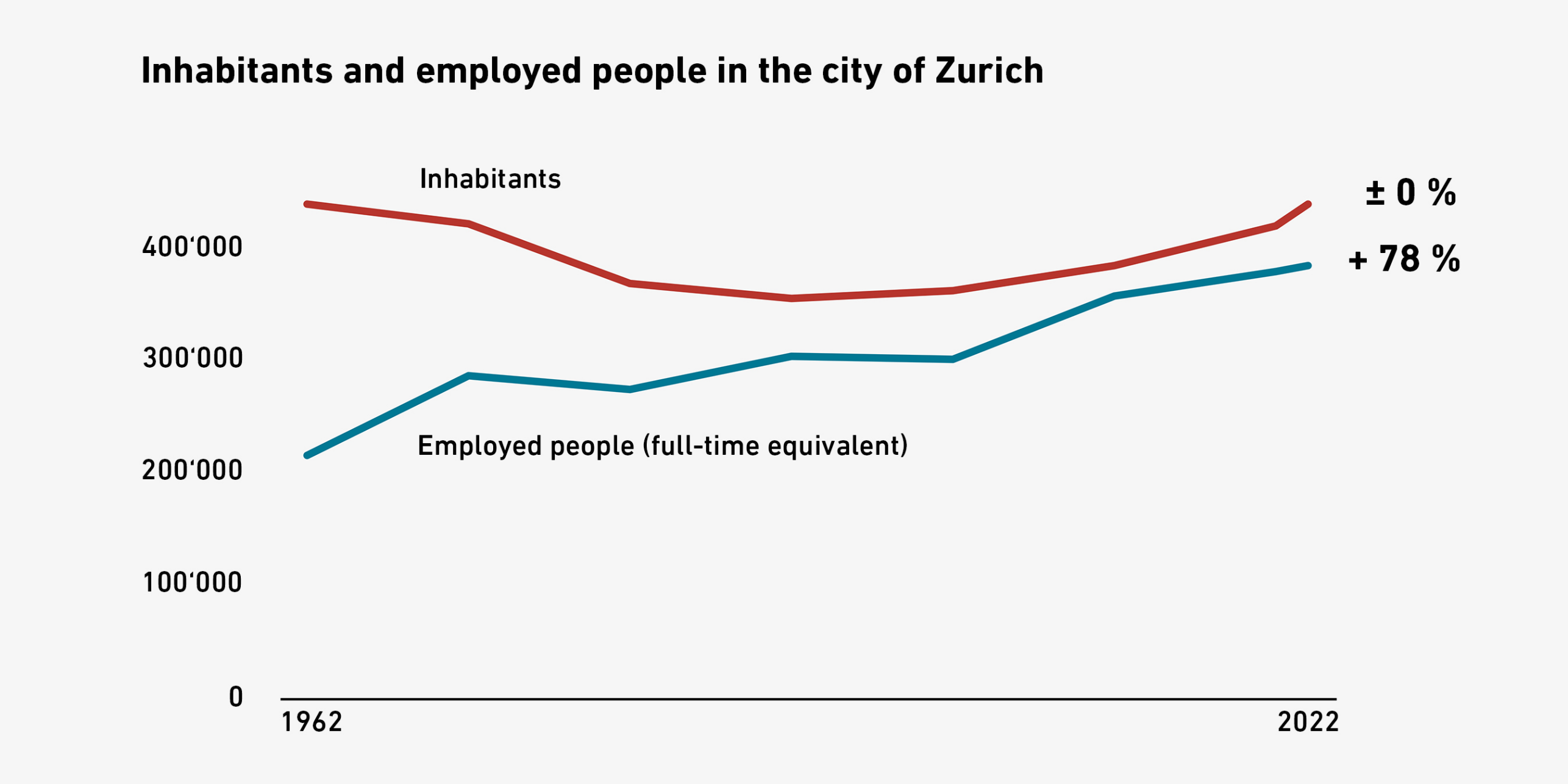
Much controversy surrounds the Neugasse project in the city Zurich. Spatial development scientist Sibylle Wälty shows how this area could contribute to alleviating the housing shortage: by building more densely than currently planned.
In May 2022, the number of inhabitants in the City of Zurich hit an all-time high of 440,1811. Although considerably more than in the 1980s and 1990s, this is only slightly more than at the last population peak in the 1960s. Yet in the meantime, many new jobs have been created - there are now near to 80 percent more than in 1960. It is evident that people who work here would also like to live nearby. Let's bear in mind that where new jobs are created, the demand for housing rises. One job is roughly equivalent to one flat (assuming occupancy by two persons). Supply and demand determine how high the rent is.

Until the turn of the millennium, new housing tended to be built in the areas surrounding the city, which worked well. But in order to put the brake on urban sprawl, the revised Spatial Planning Act came into force in 2014, leading to an even steeper rise in demand for housing in the cities. Densification seemed to be the solution, and although there was much talk of it, not enough has been or is being implemented. A case in point is the Swiss Federal Railways' (SBB) Neugasse project, which will be put to the vote for Zurich citizens on 25 September. Here, on a 30-hectare site in a well-connected location, only 375 flats are envisaged. This means that there is not sufficient densification, not as much housing is being created as would be possible.
'The 'Drittels-Ziel' draws attention away from the core problem.'Sibylle Wälty
Nowadays, rather than discussing densification, everyone's talking about the "Drittels-Ziel", which Zurich set itself in 2011. This is the goal of renting out one third of all shared flats in the city on a non-profit basis3. The intention here is to ensure affordable housing - yet the goal draws attention away from the core problem: too little housing in central locations.
Non-profit housing
So let's take a closer look at the Neugasse project, which proposes rebuilding the area to the north of the railway tracks where the SBB repair workshops are now sited. The project first hit the media a little over five years ago4. The plan then was to start building 300 to 400 flats in 2022. A third of these, i.e. some 100 to 133 flats, were to be non-profit, and a quarter of the floor area to be allocated for commercial use. The project met with opposition, however, with the most vociferous critics being the Alternative Left party5. The objection was that only one-third of the new flats would be non-profit housing - too low a proportion.
SBB then carried out a wide-ranging consultative process and presented the outcome at the beginning of 2022. In addition to 375 flats, space is earmarked for commercial and community use with some 250 workplaces, a municipal school and a kindergarten. One third of the planned housing is to be non-profit, affordable and in the middle segment of the market. The people's initiative "Eine Europaallee genügt - jetzt SBB-Areal Neugasse kaufen" (One Europaallee is enough - buy the SBB Neugasse site now!), which is now being put to the vote, calls for 100 percent of the housing to be non-profit and urges the City of Zurich to acquire the site by purchase or building rights6.
Fulfilling the legal mandate
Given that Zurich urgently needs new housing, I am of the opinion that considerably more flats should be built on the site, which is to be in the residential zone in the future, than currently planned.
If, for example, 1,500 flats were to be built instead of 375, this would allow 3,000 people to live in an attractive urban environment. That would be four times the number now planned and would help fulfill the constitutional mandate for economical land use in the city. And if half of these 1,500 flats (i.e. 750) were non-profit, this would be double the 100 per cent of 375 flats demanded by the initiative. All this would bring the city a good deal closer to its "Drittels-Ziel". The Neugasse site would offer space for 1,500 flats as well as commercial activity. The municipal school could be housed on the nearby soon-to-be vacated Josef site, which is in the public buildings zone and belongs to the city7.

Does this all sound too utopian? Well, it's fair enough to imagine how things would have turned out if the Neugasse project had taken a more holistic view of the interest in affordable housing and had paid more attention to the constitutional and statutory mandate for densification when weighing up the various aspects. Might the project now be offering housing for 3,000 people rather than a mere quarter of that number? We're not done with the discussion yet!
1external pageexternal pageStadt Zürich: Bevölkerungshöchststand übertroffen (Medienmitteilung Stadt Zürich 30.05.2022)
2external pageStatistisches Jahrbuch der Stadt Zürich
3external pageProgramm Wohnen Stadt Zürich
4external pageAufstand gegen Zürcher SBB-Wohnungen (Tages-Anzeiger 23.06.2017)external page
5external pageSBB-Areal Neugasse: ein Drittel ist nicht genug - wir wollen alles! (AL 06.03.2017)
6external pageexternal pageHundert Prozent günstige Wohnungen sollen es sein beim Zürcher Projekt Neugasse: Die Maximalforderung kommt an die Urne (NZZ 17.05.22022)
7external pageexternal pageHallenbad und Altersheim statt Kehrichtverbrennung: Auf dem Zürcher Josef-Areal entsteht ein neuer Quartierteil (NZZ 09.08.2022)






